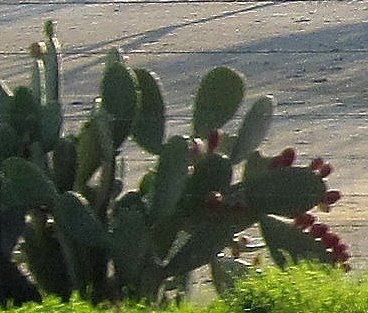Yesterday (Feb 22) was a beautiful day to drive I-5 from San Juan Bautista to Placentia. The traffic was not heavy and I took advantage of having the time to stop along the way to take photos. I won't make you suffer through more almond blossoms, although they were everywhere - for miles and miles along both sides of the highway, up into the foothills to the west and far out into the central valley on the east. Very beautiful.
 This is an acacia tree - commonly known as wattle and sometimes as mimosa. I don't know what variety is, there hundreds that are native to Australia and Africa. They are one of the first trees to come into full bloom, much to the distress of many people who suffer from allergies.
This is an acacia tree - commonly known as wattle and sometimes as mimosa. I don't know what variety is, there hundreds that are native to Australia and Africa. They are one of the first trees to come into full bloom, much to the distress of many people who suffer from allergies.  The wild mustard is blooming everywhere. It is very common in orchards, vineyards, along roadsides and in fallow fields. One story has it that the friars moving north to establish missions spread the seeds to mark the trail to the land of gold. Which isn't quite true - probably the seeds were unintentionally carried in the fur, hair and excrement of the animals they brought with them.
The wild mustard is blooming everywhere. It is very common in orchards, vineyards, along roadsides and in fallow fields. One story has it that the friars moving north to establish missions spread the seeds to mark the trail to the land of gold. Which isn't quite true - probably the seeds were unintentionally carried in the fur, hair and excrement of the animals they brought with them.  Depending on the nutritional value of the soil the individual plants can grow 3 - 4 feel tall, but they are usually about a foot high.
Depending on the nutritional value of the soil the individual plants can grow 3 - 4 feel tall, but they are usually about a foot high.  The flowers are all at the end of the stems so fields of plants look almost solid yellow.
The flowers are all at the end of the stems so fields of plants look almost solid yellow. This is a large patch of Malva neglecta, a weed which grows all over the US and Europe. It is an edible weed - leaves, stems, flowers and seed pods (or fruit as they are sometimes called).
This is a large patch of Malva neglecta, a weed which grows all over the US and Europe. It is an edible weed - leaves, stems, flowers and seed pods (or fruit as they are sometimes called). The palmated leaves when picked young taste a bit like spinach, but stronger flavored and sort of slimy like cooked okra.
The palmated leaves when picked young taste a bit like spinach, but stronger flavored and sort of slimy like cooked okra. The flowers are white to mauve (a word that derives from this plant) and are hardly noticeable because they sprout right next to the main stem and are covered by the large leaves. The flowers develop into small seed pods which resemble little cheese wheels tied with string and have a nutty flavor when eaten. [http://tinyurl.com/yax.225y] They are an interesting addition to a salad.
The flowers are white to mauve (a word that derives from this plant) and are hardly noticeable because they sprout right next to the main stem and are covered by the large leaves. The flowers develop into small seed pods which resemble little cheese wheels tied with string and have a nutty flavor when eaten. [http://tinyurl.com/yax.225y] They are an interesting addition to a salad.  Frequently along the fences separating the orchards from the highway verge there are beavertail cactus growing. The fruit of the beavertail is eaten in Mexico and SAmerica and the US Southwest raw or stewed. The 'apples' are harvested from these fence rows to sell to markets and to processors for the 'cactus jelly' seen especially in tourist shops. I don't think they have much flavor.
Frequently along the fences separating the orchards from the highway verge there are beavertail cactus growing. The fruit of the beavertail is eaten in Mexico and SAmerica and the US Southwest raw or stewed. The 'apples' are harvested from these fence rows to sell to markets and to processors for the 'cactus jelly' seen especially in tourist shops. I don't think they have much flavor.This is an enlargement of the photo above showing fruit that is ripening to the rich red color ready for harvest. Heavy gloves must be worn because the cactus and the fruit have sharp thorns.
I don't know what this plant is, but it grows in wild places and blooms about the same time as the wild mustard. It has a very tiny bloom, so it takes a lot to make a showing.
It grows in clumps to about a foot tall.
Down very close to the ground in the same area I found these tiny flowers with four or five petals. The color is much brighter and more red-violet. They cannot be seen from the highway as they grow so deep under the taller plants. I don't know the name.






2 comments:
Hi Del, thanks for the visual delight. I've had that cactus jelly-no discernible flavor there but the blooms are sure a beautiful color.
Thanks for the botany lesson - these are plants we don't see here (or if we did, I probably wouldn't recognize them) and they are all beautiful.
Post a Comment